Exploring the World's Largest Lawn Mower
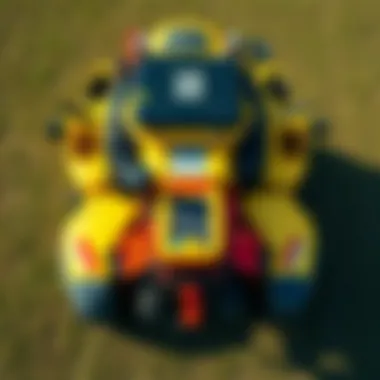
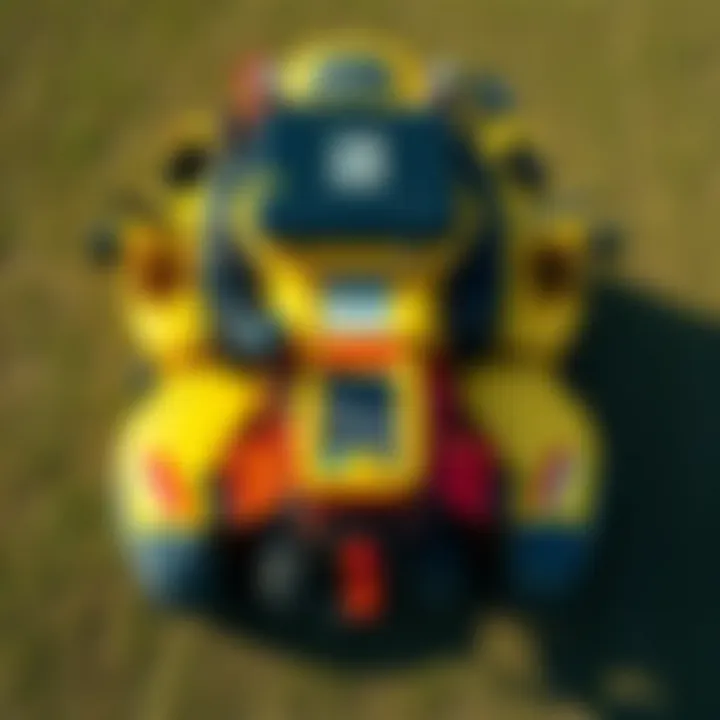
Intro
The concept of maintaining a lawn might seem like a simple task — just trim the grass and call it a day. However, with the constant expansion of agriculture and landscaping needs, the tools employed for this purpose have become incredibly sophisticated. Among them, the largest lawn mower in the world serves as a notable example, showcasing the intersection of engineering prowess and environmental considerations.
In this piece, we will traverse the landscape of lawn maintenance machinery, focusing on this remarkable machine that pushes the boundaries of what is practical in landscaping. With an eye on its specifications, history, and impact on both the industry and the environment, one can gain insights into how such innovations continue to shape our gardening practices. This exploration will not only highlight noteworthy advancements but also shed light on the future of landscaping tools.
Topic Overview
Definition and Importance
At its core, the largest lawn mower is more than just a tool; it embodies the very spirit of innovation in landscape management. This colossal machine is designed to efficiently cover vast expanses of land, streamlining tasks that would typically require numerous smaller mowers. Its importance cannot be overstated as it contributes significantly to time savings, labor reduction, and improved efficiency in lawn care.
Moreover, the introduction of large-scale mowers into the industry reflects a shifting paradigm in how landscaping is approached. No longer are landscapers limited to manual methods; technology now plays a pivotal role in determining best practices. As landscapes grow larger and more complex, this mammoth machine becomes an indispensable player in achieving optimal maintenance outcomes.
Brief History and Evolution
The journey of lawn mowers has witnessed considerable transformations since their inception. Early mowers saw limited functionality and were often cumbersome, requiring significant manpower and time. However, as technology advanced, so did the capabilities of these machines. The transition from manual push mowers to motorized models marked a significant leap.
Over the decades, key milestones shaped the design and functionalities of lawn mowers. With the advent of robotics and smart technology in lawn care, the landscape is still evolving. The emergence of the largest lawn mower signifies an apex in this evolution. This giant machine not only carries the legacy of years of engineering experimentation but also incorporates modern innovations, solidifying its role in the future of landscaping.
This exploration sets the stage for understanding how such innovations create ripple effects throughout the agricultural and landscaping industries. As technology advances, it feeds into sustainable practices and improved efficiency, paving the way for future breakthroughs.
Preamble to Lawn Mowers
When we think about lawn care, many of us picture a well-groomed yard, perhaps with vibrant flowers lining the borders and neatly trimmed grass swaying in the wind. Lawn mowers play a vital part in this picturesque scene. Understanding lawn mowers is crucial for anyone involved in landscaping, gardening, or simply maintaining their yard. This segment isn't just about machinery; it’s about the evolution of a tool that has changed the way we engage with our outdoor spaces.
Lawn mowers come in various shapes and sizes, each designed for specific tasks. From the small, manual reel mowers to colossal machines designed for vast open fields, there’s a mower suited to every kind of Lawn. It's interesting to consider how this equipment impacts not just personal gardens but also extensive commercial landscapes. Thus, diving into their history and types provides valuable context for understanding the enormity of the largest mower.
Historical Overview
The world of lawn mowers dates back to the 19th century when Edwin Beard Budding invented the first mechanical mower in 1830. This invention was a game changer, shifting lawn maintenance from labor-intensive methods to something more manageable and efficient. Initially designed for sports fields, the practical use of the mower quickly transitioned to domestic lawns. This historical evolution is not just about a tool changing hands; it’s about how societal preferences and the desire for aesthetically pleasing green spaces have influenced the development of lawn care technologies throughout the years.
Today, the melding of traditional designs with modern technology has allowed the mower industry to flourish. Innovations include electric mowers, robotic mowers, and advanced rotary designs.
Types of Lawn Mowers
Understanding the different types of lawn mowers helps us appreciate the diverse range of options available, particularly for those maintaining expansive areas of grass.
Reel Mowers
Reel mowers are often considered the original lawn mower. Their design is simple: a series of blades that rotate on a reel to cut grass. The beauty of reel mowers lies in their eco-friendliness, running purely on human power. These mowers are beneficial for smaller yards, especially where quiet operation and less environmental impact are desired. A key characteristic of reel mowers is their scissor-like cutting action, which promotes healthier grass growth compared to the tearing action of rotary mowers. However, they do require regular maintenance and can be challenging for thick or tall grass, limiting their use in larger or commercial spaces.
Rotary Mowers
Rotary mowers revolutionized lawn care by introducing the power of an engine into the mix. With a rotating blade beneath the mower deck, they can tackle thick grass and weeds with ease. The key advantage of rotary mowers is their versatility; they can cut a variety of grass types and can even handle some uneven terrains. However, this power comes with a downside—gas-powered rotary mowers can be quite noisy and may contribute to emissions, raising concerns among environmentally-conscious users. Nevertheless, for larger properties or commercial lawns, their efficiency often outweighs these drawbacks.
Robot Mowers
The rise of technology has given birth to robot mowers, which have become increasingly popular among tech-savvy homeowners. These mowers operate autonomously, cutting the grass according to a preset schedule, which allows for efficient lawn care without human intervention. The key feature of robot mowers is their ability to navigate complex terrains and avoid obstacles using sensors and GPS technology. However, while these mowers promise convenience, their price point can be a barrier—especially for those on a budget. Despite this, their appeal is growing, particularly for busy homeowners who appreciate the freedom that comes with automated lawn care.
In summation, each type of mower fills a niche in the market and understanding their roles is pivotal. This foundation sets the stage for exploring the striking contrast between standard mowers and the phenomenal machine that stands as the largest lawn mower in the world.
Defining the Largest Lawn Mower


Defining the largest lawn mower is more than just a curiosity. It's a deep look into the mechanics of machinery and what it signifies for the landscaping industry as a whole. By grasping the specifications and attributes of this colossal machine, we can appreciate its substantial impact on lawn care processes and understand how it redefines what we consider possible in agricultural technology.
Specifications and Dimensions
The largest lawn mower in the world boasts jaw-dropping specifications that are hard to fathom without a visual aid. This beast of a machine stretches to an astonishing width of 50 feet. Its cutting deck, larger than most homes, houses multiple blades that operate in harmony to create an immaculate finish on expansive lawns. In terms of height, it can tower to nearly 14 feet, allowing it to navigate terrain that standard mowers would struggle with.
The engine on this mower is another point of intrigue. It's powered by a hefty diesel engine capable of delivering upwards of 1,200 horsepower. You might wonder how much fuel it consumes; it's estimated that it uses more than 20 gallons per hour when working hard. This means that when it rolls onto a field, it's ready to tackle vast swathes of grass, outperforming conventional mowers, which are typically limited to much smaller areas and require significantly more time to cover the same distance.
"With size comes responsibility, and this mower not only recalibrates our standards in landscaping but also sets a benchmark for operational efficiency."
Comparison with Standard Lawn Mowers
To comprehend the scale and functionality of the largest lawn mower, one must first see how it stacks up against standard models. Traditional mowers, whether rotary or reel, typically operate on a scale of 20 inches to 30 inches wide. This is a noted contrast against the elephantine proportions of our subject, which effectively means that a standard mower could be dwarfed in both size and performance.
Here are some contrasting points to consider:
- Coverage Area: While a standard mower might efficiently manage an average suburban lawn of a few thousand square feet, the largest mower can handle several acres in just one pass.
- Time Efficiency: A standard mower may need several trips over a single field chore, whereas the large mower can complete the same job in mere minutes.
- Operational Complexity: Standard lawn mowers require manual effort and close monitoring. The largest lawn mower, conversely, integrates advanced technology for navigation and automated operations, making it easier to manage even for a smaller crew.
In summary, defining the largest lawn mower is not simply about its mere dimensions but also about the technological advancements that shape its performance capabilities when placed beside standard models. This comparison showcases not just how far we've come but also hints at where we could be headed in future innovations in lawn care.
Engineering Marvels Behind the Design
The engineering feats behind the largest lawn mower in the world are no small potatoes. They reflect a perfect marriage of design ingenuity and practical application, transforming what was once a rudimentary task into a spectacle of cutting-edge technology. From the materials that comprise its hulking frame to the innovative systems that enable it to operate efficiently, each component speaks volumes of human creativity and engineering prowess. Understanding these marvels offers insights into how machinery can evolve and adapt to meet the demands of modern landscaping.
Construction Materials
The choice of materials for this giant mower isn’t just about durability; it’s about performance. Steel is king here, providing the backbone for the mower's structure, while lighter composites are employed to enhance fuel efficiency. Advanced alloys might also be used, which can withstand wear and tear better than traditional materials. Consider, for instance, a tool made from high-grade aluminum for certain components. This would not only lighten the load but also resist corrosion – a typical nemesis for outdoor machinery.
Moreover, the use of wear-resistant coatings can extend the life of critical components. Just picture that: a mower tackling diverse terrains, like rocky fields or damp grasslands, yet performing smoothly and consistently. The materials chosen are purposefully selected to offer an optimal balance of strength, weight, and resilience.
Innovative Technology Utilized
At the heart of this impressive machine lies an array of technologies that might seem right out of a sci-fi movie. Let’s break it down further:
Automation
Automation stands out as one of the central features of this mower. It allows for programmed operations, minimizing human intervention. The unique characteristic of this system is its ability to learn and adapt to different terrains. This adaptability is valuable, particularly when you consider the varying needs of landscaping. Automation makes it so that the mower can operate in a routine fashion, yet respond dynamically to obstacles or changes in the environment. Its efficiency translates to considerable time savings for garden maintainers. However, while automation can be a game changer, it does present challenges. For instance, maintenance and troubleshooting can require specialized knowledge, which might not be commonly available in all regions.
Sensors
Sensors play a pivotal role in the mower's operation. Equipped with various sensors, such as proximity and terrain sensors, this mower not only cuts grass but avoids obstacles deftly. The key here is real-time data processing — as the mower moves, it constantly monitors its surroundings to ensure a smooth operation. This characteristic makes it a sound choice for avoiding damage to property or landscaping features. On the flip side, relying so heavily on sensors means that any failure in a component can lead to significant performance issues, raising maintenance concerns.
GPS Tracking
GPS tracking is another element that takes the mower's functionality to the next level. This technology affords the ability to map areas, plan optimal cutting paths, and monitor the machine's location at all times. It’s like putting a GPS chip in your dog so you always know where it runs off to! This particular tech is beneficial for folks managing larger properties, where losing track of the mower could easily lead to unkempt patches that require additional work later on. However, as with any GPS system, reliance on satellite signals can create limitations in dense or obstructed environments, presenting an occasional hiccup in its otherwise sophisticated operational capacity.
In summary, the engineering behind the largest lawn mower is a fascinating blend of modern materials and innovative technologies designed to streamline lawn care. As these developments continue, they set the stage for future advancements, paving the way for even more efficient landscaping solutions. Understanding these elements not only enriches our knowledge of the mower itself but also hints at the broader trends shaping the landscape of agricultural machinery.
Operational Efficiency
Operational efficiency is a crucial aspect when it comes to understanding the capabilities of the largest lawn mower in the world. By maximizing efficacy in how a lawn is tended, this massive machine not only optimizes labor but also compliments wider environmental goals. With lawn care taking up expansive areas, the efficiency in both operation and resource management becomes a key focal point, ensuring that the colossal mower does not merely serve as a novelty but as a valuable tool.
How It Operates
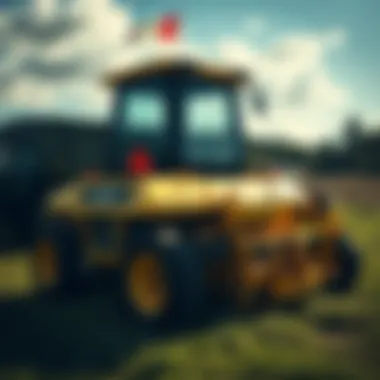
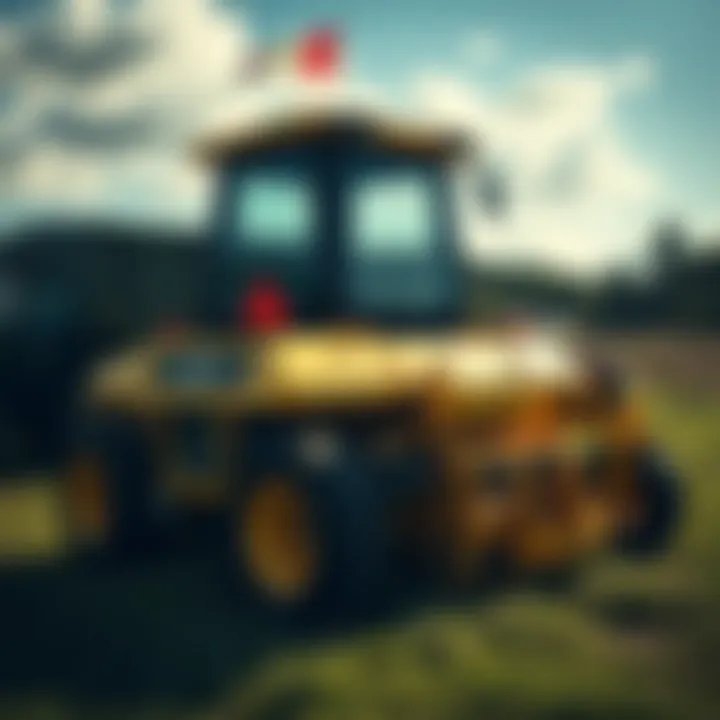
The operation of this gigantic mower bridges several engineering feats. Primarily, it utilizes a combination of advanced machinery and cutting-edge technology to achieve its goals. The mower is powered by a robust engine designed specifically to handle the extensive width and the somewhat daunting weight of the machine. The drive system is constructed to traverse various terrains, be it hilly landscapes or flat expanses.
Moreover, automation plays a vital role in its operational framework. The mower integrates systems that enable it to map and adapt to the terrain, adjusting cutting height and speed accordingly. This self-regulating mechanism means that operators spend less time worrying about adjustments and more time enjoying the efficiency the machine brings to the table. The controls are designed with user-friendliness in mind, allowing operators to easily manage functions from a centralized panel, cutting down on training time and reducing operational hiccups.
The blades themselves are engineered with precision to ensure they can slice through grass with minimal effort, thereby conserving fuel. With technology such as GPS tracking embedded into the system, the mower can efficiently navigate large spaces while avoiding obstacles, ensuring that it operates at peak productivity and maintaining an immaculate finish.
"Efficiency in mowing isn't just about cutting grass; it's about managing the entire approach to landscape maintenance."
Time and Resource Management
When discussing time management, efficiency translates directly into reduced labor hours. This enormous mower can cover ground much faster than traditional methods. For instance, while a conventional mower may take several hours to tackle a large field, the colossal mower can handle the same task in a fraction of the time. By streamlining the mowing process, it allows professionals to redirect their focus toward other vital landscape aspects, such as design aesthetics or pest control.
On the resources front, it's also interesting to note how this machine minimizes waste. Fuel consumption per square foot is lower compared to smaller motorized alternatives. And thanks to its powerful engine combined with aerodynamics designed into the mower's build, it can maintain higher efficiency over prolonged operation, ultimately leading to reduced emissions and more environmentally friendly lawn care practices.
To further illustrate the impact of efficient resource management:
- Labor Hours Saved: Operators can manage larger plots with fewer crew members.
- Fuel Savings: Enhanced engine efficiency results in lower fuel expenses.
- Maintenance Costs: The machine is built for longevity, which means that wear and tear is minimized, lowering overall maintenance costs.
Investing in such an innovative piece of equipment is a forward-thinking move for any lawn care service. Not merely a tool but a full-on partner in landscape management, the largest lawn mower makes strides in how we approach the future of lawn care, emphasizing a blend of efficacy and sustainability.
Impact on Lawn Care Industry
The introduction of the largest lawn mower has heralded significant changes in the lawn care industry. Its sheer size and advanced features not only redefine efficiency in landscaping but also prompt a reevaluation of practices and methodologies used by farmers and landscapers alike. Understanding its impact is crucial for those involved in or passionate about lawn care.
Changing Landscaping Practices
With this giant lawn mower entering the scene, traditional landscaping practices are facing an onslaught of transformation. As more landscaping companies integrate this massive machine into their fleets, they are embracing a more mechanized and less labor-intensive approach. The transition from hand-held or smaller machines to a larger model can increase productivity drastically.
Consider a scenario where a sizable estate requires regular maintenance. Formerly, this would require hours of manual labor with multiple smaller mowers or a team of workers. However, the largest lawn mower can significantly cut down these hours, effectively allowing operators to cover vast expanses in no time. With its wide cutting deck, it carves through thick grass and weeds with unparalleled ease.
This change also encourages a shift in labor dynamics. Fewer manpower needs can lead companies to allocate resources differently, putting more focus on training for specialized operation rather than manual labor. This trend could promote safety by reducing the risk of accidents associated with manual mowing, while fostering a potentially less strenuous work environment.
Economic Considerations
The economic implications of adopting such large machinery cannot be overlooked. While the initial investment for the largest lawn mower can be hefty, the return on investment (ROI) over time becomes apparent. Efficiency leads to substantial savings. Companies can service multiple clients faster than ever, leading to an increase in the number of contracts they can handle.
- Reduced Operating Costs: A larger mower consumes fuel differently compared to several smaller units. By centralizing operations with this one machine, there is a potential for reduced fuel costs, as well as savings on maintenance that multiple machines would necessitate.
- Long-Term Investment: As the industry becomes more competitive, the ability to handle larger contracts or provide faster service can set a company apart from its competitors. Investing in efficient machinery like this mower can be a game changer in an increasingly packed market.
- Job Creation in New Areas: While the machine reduces the need for labor in direct mowing tasks, it creates opportunities in new areas. Technicians trained to operate and maintain the machine are in demand, as are those who specialize in the operational and software aspects of these innovative tools.
In essence, while there might be an upfront cost, the economic revamp encouraged by integrating the largest lawn mower ultimately leads to a more efficient, productive, and responsive landscaping industry. Companies adopting these measures will likely find themselves better positioned to thrive as they overcome traditional hurdles in lawn care.
Environmental Considerations
As the world continues to grapple with climate change, it becomes ever more critical to examine the environmental footprint of our most significant technological advancements. The realm of lawn care is no exception, especially when discussing a machine of such monumental scale as the largest lawn mower. Understanding its impact on the environment is vital for farmers and gardening enthusiasts alike. The focus here will be on several key areas: carbon footprint analysis and sustainable practices integration.
Carbon Footprint Analysis
A carbon footprint assessment is foundational in gauging the environmental impact of any machinery, and the largest lawn mower is no different. Measuring the total greenhouse gas emissions associated with its production, operation, and maintenance sheds light on its overall sustainability.
While large machines like this can cover vast areas efficiently, they also consume substantial amounts of fuel, leading to higher emissions. Consider these factors:
- Fuel Type: The kind of fuel used by the machine plays a significant role in its carbon output. Diesel engines, for instance, are common in large lawn mowers but can emit higher levels of particulates and nitrogen oxides compared to cleaner alternatives.
- Operational Efficiency: The design and technology integrated into the mower can greatly affect how much fuel it consumes. Innovative technology, such as GPS tracking and automated navigation, may optimize fuel usage, which helps reduce emissions.
- Lifecycle Emissions: Not just the emissions during operation, but looking at the entire lifecycle from manufacture to disposal gives a more rounded view of its environmental impact.
Although it operates efficiently at scale, the overall carbon footprint can still raise eyebrows. Understanding this can spur further discussions on regulatory frameworks governing such devices, encouraging manufacturers to adopt greener practices.
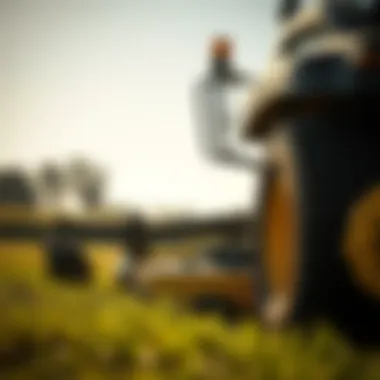
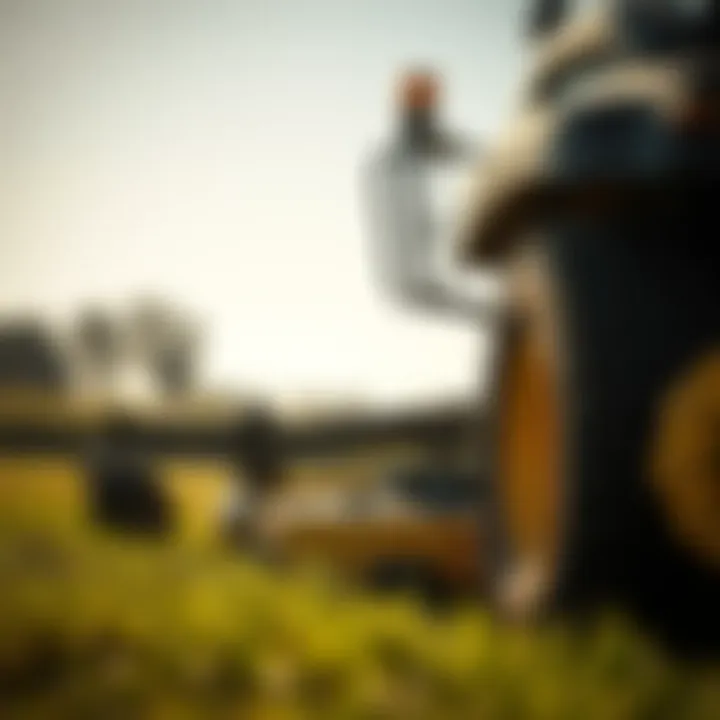
Sustainable Practices Integration
Recognizing the environmental challenges posed by large machinery opens the door for integrating sustainable practices into their design and operation. For the largest lawn mower, this involves several promising approaches:
- Biodegradable Components: Developing parts from sustainable materials reduces the long-term environmental impact. For instance, instead of traditional plastics, utilizing alternatives that break down naturally can lessen pollution.
- Regular Maintenance: A well-maintained machine not only runs better and smoother but also operates more sustainably. Regular check-ups on fuel systems and engine efficiency can help ensure emissions are minimized.
- Incorporating Renewable Energy: As technology progresses, there’s a real opportunity to integrate solar energy systems. Some innovative designs are starting to see hybrid systems that utilize solar power alongside conventional engines.
- Education and Training: Implementing training for operators on efficient mowing techniques can also minimize waste and emissions. When users are aware of how to operate machines in an eco-friendly way, they contribute positively to their surroundings.
By addressing these practices, the landscaping industry can strive toward a more sustainable future, helping to balance the scales between efficiency and environmental preservation.
"Integrating sustainability into machinery design is not just a nicety, but a necessity for the future of landscaping."
Such factors illustrate the broader implications of adopting eco-friendly practices within the industry. Through continued innovation and commitment, the potential for reducing the environmental impact of large-scale lawn care equipment is within reach.
Future Innovations in Lawn Care Technology
The world of lawn care is on the cusp of a massive transformation, driven by technological advancements. Innovations in lawn care technology are not just about making the job easier; they incorporate sustainability, efficiency, and improved performance. As we delve into this section, it’s crucial to understand how future innovations will redefine the landscaping landscape and provide solutions to problems faced by professionals and enthusiasts alike.
Emerging Technologies
The push toward integrating technology into lawn care has birthed an array of emerging technologies. For instance, drones are making waves in the agricultural sector. These flying gadgets can survey large plots of land, giving farmers insights into plant health and soil conditions. Not only do they take aerial photos, but they also can spray fertilizers and pesticides more accurately than traditional methods, reducing waste and environmental impact.
Another fascinating development is the rise of robotic lawn mowers. These devices have become more sophisticated, featuring advanced sensors and artificial intelligence. They can navigate obstacles and adapt to different terrains, promoting a greener approach to lawn maintenance. Plus, with scheduling options, home owners can have perfectly manicured lawns without ever lifting a finger.
Moreover, innovations in soil health monitoring prove promising. Companies are developing tools that can analyze soil nutrients and moisture levels in real-time. This data can help users make informed decisions about watering and fertilizing, promoting plant health while conserving resources.
Potential Developments
Looking ahead, the potential developments in lawn care technology could be game-changers. Consider smart irrigation systems designed to optimize water usage. These systems use weather data and soil moisture readings to water lawns only when necessary, potentially cutting water usage by as much as 50%. This represents not only a money-saving effort for homeowners but also addresses a critical environmental issue.
In addition to water conservation, there's a growing emphasis on sustainable materials. As environmental concerns rise, manufacturers are working on creating lawn care products made from biodegradable and recycled materials. This shift could further lessen the carbon footprint of landscaping.
Furthermore, augmented reality (AR) applications could provide new training methods for landscapers. AR can simulate lawn care scenarios, vastly improving skills without the risks and resources involved in actual practice. Users can learn about optimal equipment use or techniques simply by visualizing tasks through their smart devices.
"Innovation is the key to unlocking the future of sustainable lawn care, transforming industry practices and preserving our environment".
Epilogue
As we wrap up our exploration of the world's largest lawn mower, it becomes clear that this mechanized giant isn't just a feat of engineering prowess; it represents a profound shift in how we think about lawn care and landscaping. The implications of such a machine stretch far beyond its size and efficiency, reaching into the realms of economic and environmental factors that shape our world today.
Recap of Key Insights
- Specifications and Capabilities: The sheer dimensions and specifications of this mower reveal how advancements in technology can lead to remarkable efficiencies. With cutting widths that dwarf standard mowers and powerful engines, it enables vast expanses of grass to be managed with unprecedented speed.
- Impact on Landscaping Practices: This machine has fundamentally changed how landscaping is approached professionally. Large lawns, golf courses, or parks are now easier to maintain, allowing professionals to allocate time and resources more effectively.
- Environmental Considerations: There’s a duality in the sustainability aspect. While it takes more energy to operate, its efficiency can reduce the overall carbon footprint by allowing for more extensive areas to be cut in less time. Hence, paving the way for greener practices, if used correctly.
- Future Innovations: The integration of advanced technologies such as GPS and automation doesn’t just make the mower remarkable; it lays the groundwork for future advancements in agricultural machinery, pushing the envelope of efficiency even further.
Each of these points reflects a significant takeaway from understanding the capabilities of the largest lawn mower in the world. We'll no doubt see how these insights influence the broader landscape of lawn care in the years to come.
Final Thoughts on the Future of Lawn Care
The future of lawn care is poised for transformation as technologies continue to evolve. As larger machines become more common, we can expect a ripple effect throughout the industry. Companies will need to balance efficiency with eco-friendliness, navigating the tightrope between productivity and sustainability.
We might even see innovations that go beyond mere size. Innovations could range from autonomous robots that work alongside these large mowers, to sustainable materials that construct these machines, ultimately benefiting not just professional landscapers but also homeowners with humble plots of grass.
The implications of such advancements could redefine landscaping, from how we manage our gardens to how landscapes are designed in urban environments. Whatever the future holds, it's clear that the largest lawn mower isn't just another tool—it's a reflection of an evolving industry that is responding to modern needs while keeping an eye on sustainability.
"This is just the tip of the iceberg; as we delve deeper into technology, the possibilities for large-scale lawn care will only expand."
In essence, as we push forward with innovations and considerations for ecology, we are set to witness a significant evolution in how lawns are maintained, leading towards a future where efficiency and sustainability work hand-in-hand.
For more detailed information on lawn care advancements, check out resources like Britannica and Wikipedia.
In the grand scheme, these advancements underline a fundamental lesson: the future of lawn care is not just in the tools we use, but in the way we integrate them into our broader ecological narrative.



